Now Reading: What Is a Competitive Analysis — and How Do You Conduct One?
-
01
What Is a Competitive Analysis — and How Do You Conduct One?
What Is a Competitive Analysis — and How Do You Conduct One?

Competitive analysis is a critical component of any business strategy — whether you’re a small business owner or competing with global brands.
A competitive analysis report is the key to understanding your brand’s position in the market. Its purpose is to map competitors’ strengths and weaknesses, identify your own, and discover growth opportunities for your business.
In this article, I’ll take you through each step of a thorough competitive analysis (also known as “competitor analysis” or “competitor research”), sharing tips from marketing experts along the way.
Whether you choose to go through each step or just sample from a few sections is up to you. The point is to gather enough information to understand the competition so you can lead the pack rather than just trying to stay ahead of the curve.
Table of Contents
What is competitive analysis?
Competitive analysis is the process of comparing your competitors against your brand to understand their core differentiators, strengths, and weaknesses. It’s an in-depth breakdown of each competitor’s market position, sales & marketing tactics, growth strategy, and other business-critical aspects to see what they’re doing right and find opportunities for your business.
Competitive analysis gives you a clearer picture of the market landscape to make informed decisions for your growth.
That said, you have to remember that competitive analysis is an opportunity to learn from others. It isn’t:
- Copying successful competitors to a T.
- Trying to undercut others’ pricing.
- A one-and-done exercise.
Let’s look at how competitor research can help your business before breaking down my 5-step competitive analysis framework.
Why do a competitor analysis?
If you’re unsure about investing time and effort in analyzing your competitors, know that it will give you a complete picture of the market and your position in it.
Here are six main reasons I perform a competitive analysis exercise whenever working with a brand for the first time.
1. Find competitors’ strengths and weaknesses.
What are your competitors doing right when it comes to driving their growth? Analyzing the ins and outs of an industry leader will tell you what they did to reach the top position in the market.
By looking at competitor strengths and weaknesses, you will identify your own strengths and weaknesses in comparison, and thus see opportunities to improve.
I personally love analyzing competitor strengths. It’s easy to become short-sighted when looking only at your own website, marketing, and business. Analyzing competitors will open your eyes to current industry trends, what works well, and what would benefit your business.
Competitor weaknesses are of equal importance, particularly if you’d love to be in the position your competitors are in. Analyze areas in which they fall short and devise a plan to avoid making the same mistakes.
Pro tip: Look at company and product reviews to find the weaknesses that most bother your audiences. Commonalities can be used in marketing messaging to persuade people to try your business instead of another. Or, you can go into product development knowing exactly what problem to solve.
2. Identify opportunities.
Conducting a competitor analysis can be hugely beneficial because it’s an affordable way to identify opportunities to improve your business.
One strategy is to build a picture of the messaging that works for a competitor by analyzing what they say about their products or unique selling points (USPs). This information might inspire your own marketing.
Rachel Andrea Go is a marketing director who uses competitor analysis to learn what messages resonate with her audiences. She recommends, “Instead of saying, ‘Best project management software,’ one of your competitors might say, ‘Get time back by letting our software manage your projects.’
“By framing their software as ‘time-saving,’ your competition positions their software not only as a solution for project managers but also as a way to save time.
“Look at the language they employ on their websites, landing pages, and social media posts to communicate their USPs and pay attention to how their followers react.”
Pro tip: Don’t get too hung up on closing the gap on competitors. It’s easy to get carried away with competitor analysis and lose sight of what really matters to drive your business, but keep your business front of mind at all times. Do the analysis, but think carefully about which opportunities are a) right for your business and b) likely to move the needle.
3. Identify your differentiators.
Think of competitor analysis as a chance to reflect on your own business and discover what sets you apart from the crowd.
There’s no doubt that there will be some key differentiators between your business and your competitors that you’ll be glad to see.
But if you keep an open mind while conducting your analysis, there’s a good chance you’ll find differentiators in messaging, word choices, and USPs that will make you think about your own business differently.
Pro tip: Be strategic about competitor analysis. It’s common for brands to focus on the most aspirational competitors, but you need to consider your market position honestly. Don’t be afraid to dream big, but balance analysis of the biggest players with some that are closer to where your business is currently located.
4. Get closer to your target audience.
A good competitor analysis framework zooms in on your audience. It takes the pulse of your customers by evaluating what they like, dislike, prefer, and complain about when reviewing competing brands.
You can discover how your audience talks about competitors, what they love, and what they loathe. Emulate the things they love if it makes sense to do so, and avoid what they loathe — or use it to your advantage.
Pro tip: Social media, forums, and review sites are excellent sources of qualitative data where you can learn your audience’s feelings and perceptions in their own words. Or, go further and use surveys to get a sense of their activities, interests, and opinions (AIO).
5. Discover new competitors.
This one might sound backward. Don’t you need to know your competitors before you can start competitive analysis? Well, yes … and no.
As mentioned above, I’ve seen many brands fall into the trap of analyzing aspirational competitors and miss out on other brands that are attracting their audiences.
David Hunter, a digital marketing professional and the founder of Local Falcon — a local SEO rank-tracking tool powered by advanced AI — says, “One of the best ways to identify competitors is by looking at who ranks for the same keywords your business is targeting.”
“I always start by running a simple Google search using industry-related terms and tracking which businesses consistently show up,” he tells me. “If a company is frequently outranking you on search or maps, they’re a competitor, even if they’re not offering an identical product.”
When it comes to digital competitor research, SEO, and content, another way to look at it is “business competitors” and “content competitors.”
Think of your business competitors as those who do the same kind of work you do — the ones you might lose business to. Content competitors, however, may be serving your audience online, bringing them into communities, or providing alternative solutions that could leave you forgotten.
Pro tip: In a digital world, it’s almost impossible to know who all of your competitors are. It’s important to keep an eye on those that are local and those that are not, and to categorize the types of competition.
6. Set benchmarks for success.
A competitor analysis gives you a realistic idea of mapping your progress with success metrics. While every business has its own path to success, you can always look at a competitor’s trajectory to assess whether you’re on the right track for growth.
Pro tip: If you can check in regularly, say every 3, 6, or 12 months, you can note which KPIs to monitor. I tend to do competitor analysis every year or so for my clients. You can compare reports to previous years to track the trajectory.
The bottom line: Whether you’re starting a new business or revamping an existing one, a competitive analysis eliminates guesswork and gives you concrete information to build your business strategy.
What is competitive market research?
Competitive market research is a vital exercise that goes beyond merely comparing products or services. It involves an in-depth analysis of the market metrics that distinguish your offerings from those of your competitors.
Thorough market research doesn’t just highlight these differences, it also leverages them. This lays a solid foundation for a sales and marketing strategy that differentiates your business in a bustling market.
In the next section, I’ll walk you through the nuts and bolts of conducting a detailed competitive analysis that’s tailored to your brand. But first, let’s talk about the essentials.
Essential Aspects to Cover in Competitive Analysis Research
Before I go through the step-by-step process for conducting competitor research, I want to highlight the main aspects to include for every competitor in your analysis:
- Overview. A summary of the company — location, target market, and target audience.
- Primary offering. A breakdown of what they sell and how it compares to your brand.
- Pricing strategy. A comparison of your pricing against their pricing for various products.
- Positioning. An analysis of their core messaging to see how they position themselves.
- Customer feedback. A curation of what customers have to say about the brand.
How to Conduct Competitive Analysis in 5 Quick Steps
Below, I’m covering how to do a competitive analysis in five steps (the quick version) and then I’ll go in-depth with an “extended cut,” which is packed with a lot more tips. Whichever you choose, remember that the point is to:
- Identify gaps in the market.
- Develop new products and services.
- Uncover market trends.
- Market and sell more effectively.
And remember, whether or not you’ve got a marketing team behind your brand, the good news is that competitor analysis is getting even easier and less time-consuming. According to HubSpot’s 2024 State of Marketing report, 33% of marketers say AI is helping with research, ranking it #1, above context creation (31%) and data analysis and reporting (30%).
1. Identify and categorize all competitors.
The first step is a simple yet strategic one. You have to identify all possible competitors in your industry, even the lesser-known ones. The goal here is to be aware of all the players in the market instead of arbitrarily choosing to ignore some.
As you find more competitors, categorize them into these buckets:
- Direct competitors. These brands offer the same product/service as you to the same target audience. People will often compare you to these brands when making a buying decision. For example, Arcade and Storylane are direct competitors in the demo automation category.
- Indirect competitors. These businesses solve the same problem but with different solutions. They present opportunities for you to expand your offering. For example, Scribe and Whatfix solve the problem of documentation + internal training, but in different ways.
- Legacy competitors. These are established companies operating in your industry for several years. They have a solid reputation in the market and are a trusted name among customers. For example, Ahrefs is a legacy competitor in the SEO industry.
- Emerging competitors. These are new players in the market with an innovative business model and unique value propositions that pose a threat to existing brands. For example, ChatGPT came in as a disruptor in the conversational AI space and outperformed several brands.
For example, here’s a competitive matrix classifying brands in the community and housing space:
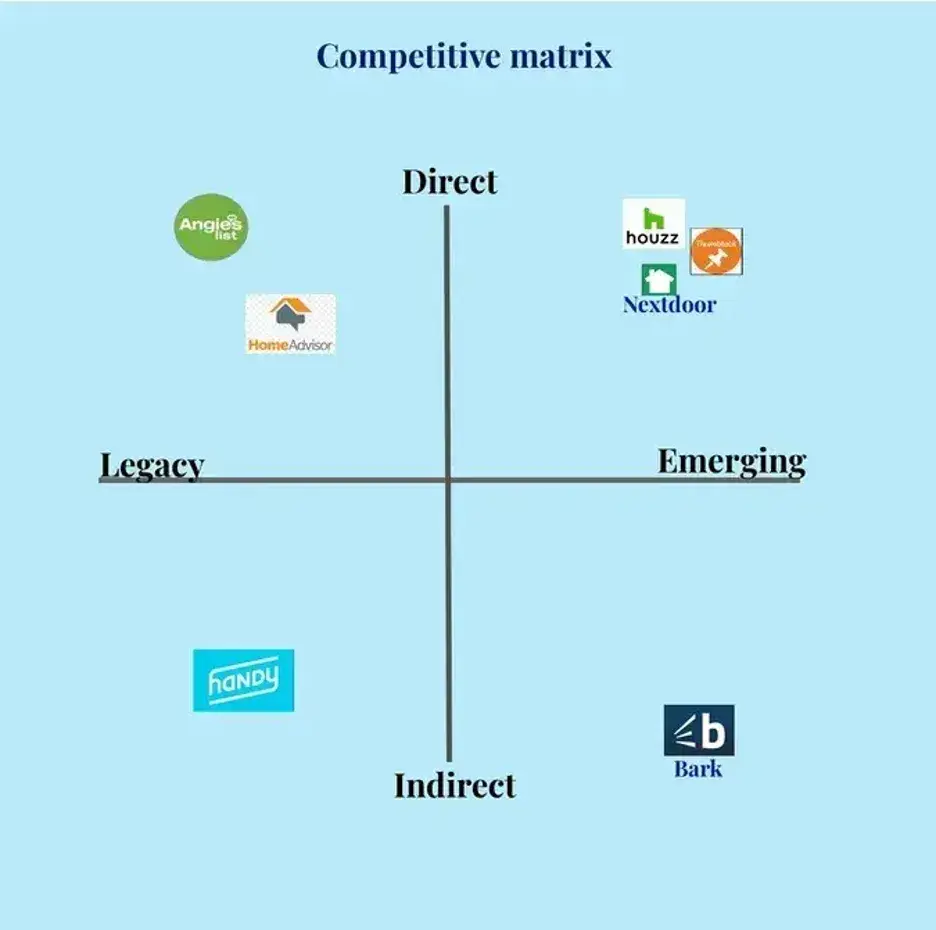
Testing It Out
To help you understand each step clearly, I’ll use Trello as an example brand and create a competitor analysis report using these steps.
Here’s a table of the main competitors for Trello:
|
Type of competitors |
Competitor names |
|
Direct competitors |
Asana, Basecamp, Monday.com, MeisterTask |
|
Indirect competitors |
Slack, Notion, Coda |
|
Legacy competitors |
Microsoft Project, Jira |
|
Disruptor competitors |
ClickUp, Airtable |
2. Determine each competitor’s market position.
Once you know all your competitors, start analyzing their position in the market.
This step will help you understand where you currently stand in terms of market share and customer satisfaction. It’ll also reveal the big guns in your industry — the leading competitors to prioritize in your analysis report.
Plus, visualizing the market landscape will tell you what’s currently missing. You can find gaps and opportunities for your brand to thrive even in a saturated market.
To map competitors’ market positions, create a graph with two factors: market presence (Y-axis) and customer satisfaction (X-axis). Then, place competitors in each of these quadrants:
- Niche. These are brands with a low market share but rank high on customer satisfaction. They’re likely targeting a specific segment of the audience and doing it well.
- Contenders. These brands rank low on customer satisfaction but have a good market presence. They might be new entrants with a strong sales and marketing strategy.
- Leaders. These brands own a big market share and have highly satisfied customers. They’re the dominant players with a solid reputation among your audience.
- High performers. These are another category of new entrants scoring high on customer satisfaction but with a low market share. They’re a good alternative for people not looking to buy from big brands.
This visualization will tell you exactly how crowded the market is. But it’ll also highlight ways to gain momentum and compete with existing brands.
Testing It Out
Here’s a market landscape grid by G2 documenting all of Trello’s competitors in the project management space. For a leading brand like Trello, the goal would be to look at top brands in two quadrants: “Leaders” and “High Performers.”
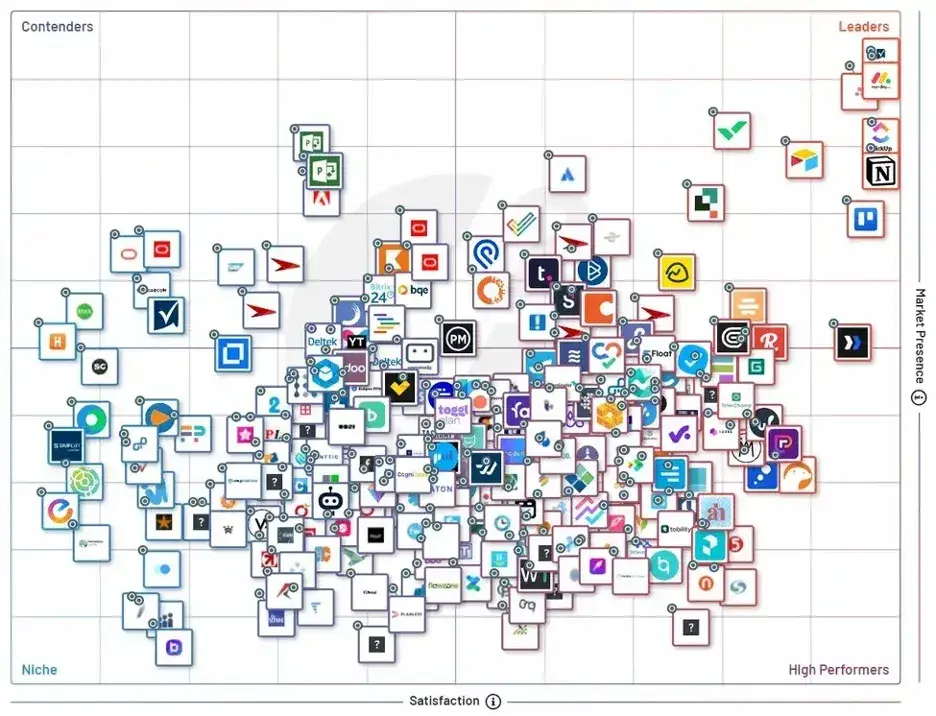
3. Extensively benchmark key competitors.
Step 2 will narrow down your focus from dozens of competitors to the few most important ones to target. Now, it’s time to examine each competitor thoroughly and prepare a benchmarking report.
Remember that this exercise isn’t meant to find shortcomings in every competitor. You have to objectively determine both the good and bad aspects of each brand.
Here are the core factors to consider when benchmarking competitors:
- Quality. Assess the quality of products/services for each competitor. You can compare product features to see what’s giving them an edge over you. You can also evaluate customer reviews to understand what users have to say about the quality of their offering.
- Price. Document the price points for every competitor to understand their pricing tactics. You can also interview their customers to find the value for money from users’ perspectives.
- Customer service. Check how they deliver support — through chat, phone, email, knowledge base, and more. You can also find customer ratings on different third-party platforms.
- Brand reputation. You should also compare each competitor’s reputation in the market to understand how people perceive the brand. Look out for anything critical people say about specific competitors.
- Financial health. If possible, look for performance indicators to assess a brand’s financial progress, using data on metrics like revenue growth and profit margins.
This benchmarking exercise will involve a combination of primary and secondary research. Invest enough time in this step to ensure that your competitive analysis is airtight.
Here’s an example of a competitor benchmarking report for workforce intelligence tools:
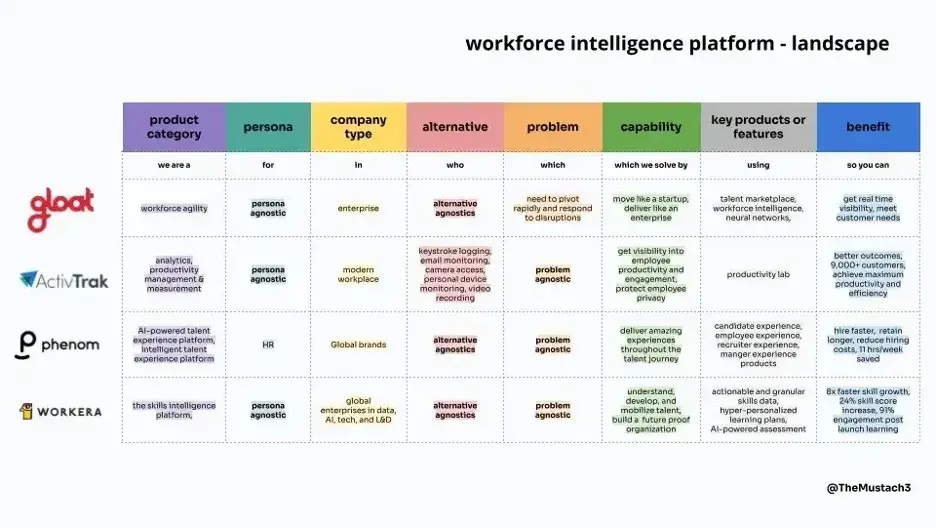
Testing It Out
In this table, I benchmarked Asana based on these criteria using the information I could find:
|
Criteria |
Asana |
|
Quality |
|
|
Price |
Offers a free tier and paid plans starting from $10.99/month per user. Advanced features and integrations are available at higher price points. |
|
Customer Service |
|
|
Brand Reputation |
Considered one of the best project management tools, with a slightly more robust feature set compared to competitors. |
4. Deep dive into their marketing strategy.
While the first few steps will tell you what you can improve in your core product or service, you also need to find how competitors market their products. A deep-dive into their marketing strategies will help you learn how they approach buyers.
I analyze every marketing channel, then note my observations on how they speak to their audience and highlight their brand personality.
Here are a few key marketing channels to explore:
- Website. Analyze the website structure and copy to understand their positioning and brand voice.
- Email. Subscribe to emails to learn their cadence, copywriting style, content covered, and other aspects.
- Paid ads. Use tools like Ahrefs and Semrush to find if any competitor is running paid ads on search engines.
- Thought leadership. Follow a brand’s thought leadership efforts with content assets like podcasts, webinars, courses, and more.
- Digital PR. Explore whether a brand is investing in digital PR to build buzz around its business and analyze its strategy.
- Social media. See how actively brands use different social channels and what kind of content is working best for them.
- Partnerships. Analyze high-value partnerships to see if brands work closely with any companies and mutually benefit each other.
I recommend creating a document capturing every detail of a competitor’s marketing strategy. This will give you the right direction to plan your marketing efforts.
5. Perform a SWOT analysis.
The final step in a competitive analysis exercise is creating a SWOT analysis matrix for each company — and yours, too, so you can compare.
SWOT stands for strengths, weaknesses, opportunities, and threats, and this is what you’ll identify in this step.
- Strengths. Identify your strengths. These may include specific pieces of intellectual property, products that are unique to the market, or a workforce that outperforms the competition.
- Weaknesses. Here, it’s worth considering potential issues around pricing, leadership, staff turnover, and new competitors in the market.
- Opportunities. This part of the SWOT analysis can focus on new market niches, evolving consumer preferences, or new technologies being developed by your company.
- Threats. These might include new taxes or regulations on existing products or an increasing number of similar products in the same market space that could negatively affect your overall share.
Questions to consider:
- What is your competitor doing well?
- Where do they have an advantage over your brand?
- What is the weakest area for your competitor?
- Where does your brand have the advantage over your competitor?
- In what areas would you consider this competitor a threat?
- What could competitors do better?
- Are there opportunities in the market that your competitor has identified?
With these answers, you’ll be able to compare their weaknesses against your strengths and vice versa. By doing this, you can better position your company, and you’ll start to uncover areas for improvement within your own brand.
Use tools like Miro to visualize this data and you’ll get a clearer idea of where you can outgrow each competitor.
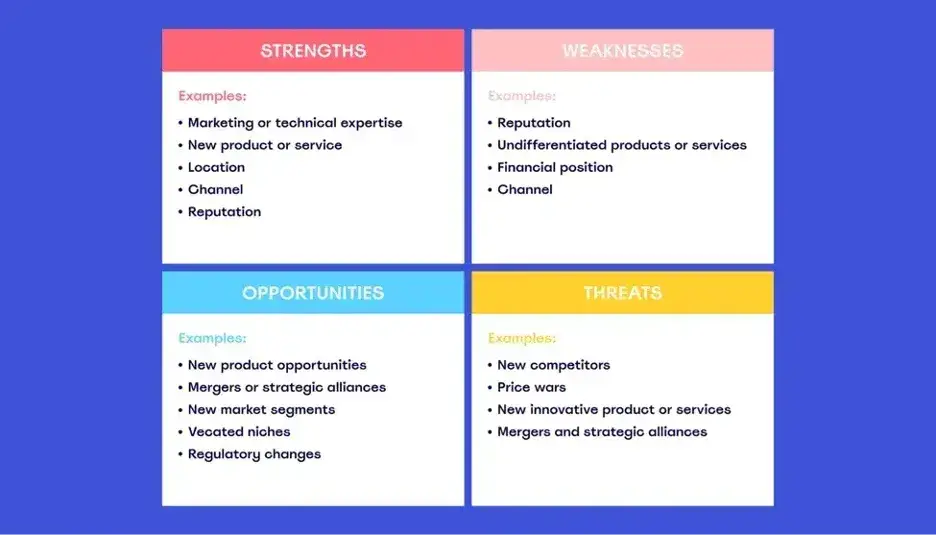
Testing It Out
Here’s a SWOT analysis matrix I created for Asana as a competitor of Trello:

How to Do a Competitive Analysis (the Extended Cut)
- Determine who your competitors are.
- Determine what products your competitors offer.
- Research your competitors’ sales tactics and results.
- Take a look at your competitors’ pricing, as well as any perks they offer.
- Ensure you’re meeting competitive shipping costs.
- Analyze how your competitors market their products.
- Take note of your competition’s content strategy.
- Learn what technology stack your competitors use.
- Analyze the level of engagement on your competitors’ content.
- Observe how they promote marketing content.
- Look at their social media presence, strategies, and go-to platforms.
- Perform a SWOT Analysis to learn their strengths, weaknesses, opportunities, and threats.
In this section, I’ll go over the competitor research process I outlined above, but with additional steps. To help me get into the weeds on this topic, I talked to marketing experts who use competitive analysis in their agencies and asked them to explain to me how they carry out their analyses. They had a wealth of tips to share.
And if you’re ready to get started on a complete and effective competitive analysis on your own, download these free competitive analysis templates, which range in purpose from sales to marketing to product strategy.
Featured Resource: 10 Competitive Analysis Templates
1. Determine who your competitors are.
First, figure out who you’re competing with. As mentioned earlier, this might not be who you think it is, and you should use multiple sources to see what brands pop up.
“To determine your competitors, start by talking with your internal teams to learn who they consider competitors,” says Jennifer Hall, associate director of agency marketing at Vision Media.
“If you regularly do client interviews, you can include [the other brands] they were thinking of when shopping for your product or service.”
Hall also suggests “surveying your customer service team since they directly connect with your customers” and ensuring that “your sales teams ask prospects who else they have spoken to.” You’ll want to know who a prospect went to if they didn’t choose you.
And, as discussed in the sections above, she mentions the importance of keyword searches. “Search online for your product or service and see what other businesses come up for the main keywords that reflect your business.” Once you have a list, she advises using tools like SparkToro, SEMRush, or Ahrefs to collect competitor analytics on keywords, rankings, domain ranking, authority, and engagement.
The key thing to remember when determining the competition is that: “You should see the same names coming up, but you should also see some surprises,” Hall tells me. “Your stakeholders may not consider your business in the same category… but if prospects are considering them then you need to include them in your analysis.”
2. Determine what products your competitors offer.
Once you’ve got a competitor list, you’ll want to analyze your competitor’s complete product line and the quality of the products or services they’re offering. You should also take note of their pricing structures and any discounts they’re offering customers.
To get started, David Hunter of Local Falcon, says, “A competitor’s website is the first stop, but it’s not the only place to look. I dig into customer reviews and FAQs because they often reveal details that aren’t obvious on the main site.”
Google Business profiles, ecommerce platforms, and industry forums are other places to expose hidden offerings, Hunter tells me. “Sometimes, competitors package their products differently or provide unique services that you wouldn’t notice just by skimming their homepage.”
Questions to consider:
- Are they a low-cost or high-cost provider?
- Are they working mainly on volume sales or one-off purchases?
- What is their market share?
- What are the characteristics and needs of their ideal customers?
- Are they using different pricing strategies for online purchases versus brick-and-mortar?
- How does the company differentiate itself from its competitors?
- How do they distribute their products/services?
3. Research your competitors’ sales tactics and results.
Next, research sales tactics and their results. The purpose is to give you an idea of how competitive the sales process is and what information your sales reps will need in order to compete during the final-buy stage.
For this, the number one tip I heard was: become their lead.
“We signed up for three competitors’ free trials using different company email addresses and documented their entire sales sequence, from initial outreach timing to follow-up cadence and objection handling,” says Matt Bowman, CEO and founder of Thrive Local.
“Email sign-ups and lead magnets can reveal a lot about their approach,” Hunter adds.
“Don’t hesitate to mystery shop a competitor by completing an online contact form, emailing a business development contact, or visiting their locations,” Jennifer Hall tells me. “Follow them on their social media channels and subscribe to their newsletters to receive constant updates on what they are doing.”
But there are other approaches as well. “I pay attention to how competitors structure their sales funnel. Are they offering free trials, demos, or limited-time discounts?” details Hunter. “Also, analyzing their ad strategies through tools like Meta Ads Library or Google Ads transparency tools can give insights into which promotions they’re running and how aggressive they are with paid acquisition.”
Another option, says Hall, is to ask clients who have been with competitors in the past. This gives you room to find out about sales tactics and also why the client switched.
Questions to consider:
- What does the sales process look like?
- What channels are they selling through?
- Do they have multiple locations, and how does this give them an advantage?
- Are they expanding? Scaling down?
- Do they have partner reselling programs?
- What are their customers’ reasons for not buying? For ending their relationship with the company?
- What are their revenues each year? What about total sales volume?
- Do they regularly discount their products or services?
- How involved is a salesperson in the process?
4. Take a look at your competitors’ pricing, as well as any perks they offer.
Correctly pricing your product has a lot to do with how much your competitors are charging for a similar product or service.
“Pricing isn’t always easy to find, but it’s worth the effort,” Hunter tells me. “If it’s not listed publicly, I look at customer reviews, which sometimes mention price ranges, or check aggregator sites that compare services.”
If you feel your product offers superior features compared to those of a competitor, you might consider making your product or service more expensive than industry standards. But if you do, ensure your sales reps are ready to explain why your product is worth the additional cost.
Alternatively, perhaps you feel there’s a gap in your industry for affordable products. If that’s the case, you might aim to charge less than competitors and appeal to prospects who aren’t looking to break the bank for a high-quality product.
In addition, “Some businesses use perks — like extended warranties or loyalty programs — to offset higher pricing. Understanding this helps in positioning your own pricing strategy effectively,” Hunter concludes.
5. Ensure you’re meeting competitive shipping costs.
Did you know that expensive shipping is the most frequently cited reason for cart abandonment?
“For ecommerce businesses, competitive shipping rates can make or break conversions,” says Hunter.
“I analyze what competitors are charging for shipping, whether they offer free shipping thresholds, and if they have partnerships with carriers for better rates,” he continues.
“If a competitor is absorbing shipping costs, it’s important to assess whether that’s sustainable for your business or if you need to offer something of equal value.”
6. Analyze how your competitors market their products.
Analyzing marketing efforts means gauging the channels through which marketing happens and what types of assets are created.
The first step is to “run Google searches by category, visit their websites, and review their products and services pages,” advises Hall.
To go further, “I reverse-engineer competitor marketing by tracking their ad placements, looking at their organic social presence, and seeing where their traffic comes from,” Hunter says. “If they’re running successful PPC campaigns, those keywords are worth noting.”
He also mentions using tools like SEMrush or Ahrefs to “help map out content gaps and reveal which marketing channels are actually driving traffic.”
Lastly, “Pull exact messaging and creative examples from the competitive data platforms to review what channels and spend levels support their messages,” says Max Barkley, associate director of digital strategy at Vision Media — who focuses on competitive analysis as it relates to media buying agencies.
To start, track if competitors are using any of the following:
- Blogs
- Whitepapers or ebooks
- Videos or webinars
- Podcasts
- Static visual content, such as infographics or cartoons
- Slide decks
- Website FAQs section
- Featured articles
- Press releases
- Media kit
- Case studies
- Buying guides and data sheets
- Online and offline ad campaigns
7. Take note of your competition’s content strategy.
Once you understand the channels and assets, take a look at the quantity and frequency of output. Are there hundreds of blog posts or just a few? Are they publishing weekly, monthly, or even less often?
“I analyze which platforms competitors prioritize, how often they publish, and what type of engagement their content gets” Hunter explains. “If a competitor is dominating short-form video or thought leadership content, it’s a sign to explore those formats yourself.”
Another pro tip is to “add them to your competitor list on LinkedIn to track their follower metrics,” says Hall.
It’s also a perfect place to inject some basic AI tools, like ChatGPT, Claude, or Perplexity.
“With the right prompts, your favorite AI assistant can provide all the information you’re looking for. But,” she adds, “remember to vet the responses.”
Questions to consider:
- How accurate is their content?
- Are spelling or grammar errors present?
- How in-depth does their content go? (Is it at the introductory level, just scratching the surface, or does it include more advanced topics with high-level ideas?)
- What tone do they use?
- Is the content structured for readability? (Are they using bullet points, bold headings, and numbered lists?)
- Is their content free and available to anyone, or do their readers need to opt in?
- Who is writing their content? (In-house team? One person? Multiple contributors?)
- Is there a visible byline or bio attached to their articles?
- What photos or imagery do they use? Stock photos? Illustrations? Custom? (And with stock photos, do they use quotes or calls-to-action specific to their business?)
All of this will give you a solid understanding of your competitors’ content marketing strategy.
8. Learn what technology stack your competitors use.
Understanding what types of technology your competitors use can be critical for helping your own company reduce friction and increase momentum within your organization.
“Tech stacks tell a lot about efficiency and automation,” Hunter tells me. “Tools like BuiltWith and Wappalyzer reveal what software competitors use for everything from email marketing to customer support. If a competitor is scaling rapidly, their tech choices can give clues about what’s working for them.”
Max Barkley agrees, adding Ghostery as an additional tool to analyze competitors’ ad tech, analytics, and CRM tools.
As another route, you can also look at competitors’ job listings, particularly for engineer or web developer roles. The job listing will likely mention which tools a candidate needs to be familiar with — a creative way to gain intel into the technology your competitors use.
9. Analyze the level of engagement on your competitor’s content.
To assess how engaging your competitor’s content is to their readers, you’ll need to see how their target audience responds to what they’re posting.
“Engagement metrics show more than just vanity likes — they highlight what resonates with an audience,” explains Hunter. “I track comment sentiment, share frequency, and how competitors respond to questions. If a specific content format consistently drives high engagement, it’s a clear signal that it’s worth testing.”
When assessing your competitor’s content, ask the following:
- Do certain topics resonate better than others?
- Are the comments negative, positive, or mixed?
- Are people tweeting about specific topics more than others?
- Do readers respond better to social updates about certain content?
- Do competitors categorize their content using tags?
- Do they have social media follow and share buttons attached to each piece of content?
10. Observe how they promote their marketing content.
From engagement, you’ll move along to your competitor’s content promotion strategy.
“Promotion strategies often dictate how successful content is. Some brands rely heavily on paid ads, while others thrive through partnerships or influencer collaborations. Tracking backlink strategies and cross-promotion tactics can reveal gaps in your own approach,” Hunter advises me.
Questions to consider:
- Which keywords are your competitors focusing on that you haven’t tapped into?
- What content is highly shared and linked to? How does your content compare?
- What other sites are linking back to your competitor’s site but not yours?
- Who else is sharing what your competitors are publishing?
- Who is referring traffic to your competitor’s site?
- For the keywords you want to focus on, what is the difficulty level?
11. Look at their social media presence, strategies, and go-to platforms.
Evaluate your competitor’s social media presence and engagement rates to see how you compare and where you can improve.
“Every platform has a different user base, and competitors choose their social presence based on where their audience engages most,” Hunter explains. “I analyze post frequency, content format, and community interaction. If a competitor is gaining traction on a new platform, it might be worth exploring before the space becomes saturated.”
Questions to consider:
- How does your competition drive engagement with their brand through social media?
- Does your competitor have links to their social media channels in the header, footer, or somewhere else? Are these clearly visible?
- Do they use calls-to-action?
- Are they more focused on driving people to landing pages, resulting in new leads? Or are they posting visual content to promote engagement and brand awareness?
- How much of this content is original? Do they share curated content from other sources? Are these sources regular contributors? What is the overall tone of the content?
- How does your competition interact with its followers? How frequently do their followers interact with their content?
12. Perform a SWOT Analysis to learn their strengths, weaknesses, opportunities, and threats.
The last step is to create a SWOT analysis, which we delved into pretty deeply in the “5 quick steps” section above. The main point is to compare the strengths and weaknesses of your brand and those of the competition. This is a great place to visualize the research you’ve compiled up to this point, and start putting all the pieces together.
However, “A proper SWOT analysis isn’t just about identifying strengths and weaknesses — it’s about actionable insights. I look at what competitors are doing exceptionally well, where they fall short, and what external opportunities and threats exist for the industry as a whole. This perspective helps businesses not only compete but also differentiate,” concludes Hunter.
Competitive Analysis Templates
As I’m sure you can tell, competitive analysis is complex — especially when you’re assessing multiple companies and products simultaneously.
To help streamline the process, we created 10 free templates that help you see how you stack up against the competition, and what you can do to increase market share.
When you download the free templates, you’ll have access to:
- Two-Feature Competitive Landscape Chart
- Competitor Strategic Overview
- Content Marketing Analysis Template
- You vs. Competitor Side-By-Side
- Competitor Battle Card
- Multiple Competitor Feature Comparison
- Multiple Competitors Scoring Card
- SWOT Analysis Template
- Categorical Feature Comparison Template
- Review Tracker
Competitive Analysis Example
By now, the goal of competitive analysis should be clear. How do you stack up against the competition? Where are you similar, and what sets you apart?
By understanding this, you’re better positioned to make strategic decisions that can help grow your brand.
Of course, it’s one thing to understand the benefits of competitive analysis, and it’s another to actually carry out an analysis that yields actionable results. If you want to see how it’s down, I’ve got you covered with a quick case study.
Sony vs. Nintendo
Let’s take a look at popular gaming system companies Sony and Nintendo.
When Sony’s PlayStation 5 hit the market in late 2020, it was plagued by supply shortages.
Nintendo’s Switch console, meanwhile, had been around since 2017, but remained a consistent seller, especially among teens and children.
This scenario is familiar for many companies on both sides of the coin; some have introduced new products designed to compete with established market leaders, while others are looking to ensure that reliable sales don’t fall.
Using some of the steps listed above, I’ll go through this case as a competitive analysis example.
1. Determine who your competitors are.
In our example, it’s Sony vs. Nintendo, but it’s also worth considering Microsoft’s Xbox, which occupies the same general market vertical.
This is critical for effective analysis; even if you’re focused on specific competitors and how they compare, it’s worth considering other similar market offerings.
2. Determine what products your competitors offer.
PlayStation offers five PS5 versions at different price points — digital and disc editions, the slim versions of the digital and disc editions, and the Pro. Nintendo, meanwhile, offers three versions of its console.
Both companies also sell peripherals — for example, Sony sells virtual reality (VR) add-ons, while Nintendo sells gaming peripherals such as steering wheels, tennis rackets, and differing controller configurations.
3. Research your competitors’ sales tactics and results.
When it comes to sales tactics and marketing, Sony and Nintendo have very different approaches.
In part thanks to a semiconductor shortage, Sony drove up demand via scarcity — with very low volumes of PS5 consoles available. While Nintendo adopted a broader approach by targeting families as its primary customer base.
This effort was bolstered by the Switch Lite product line, which is smaller and less expensive, making it a popular choice for children.
As of December 2024, Nintendo had sold 150.86 million units globally, while Sony had sold 74.9 million. While it’s true that Nintendo had a three-year lead, it was still outselling Sony in the 12-month period of 2024.
4. Take a look at your competitors’ pricing, as well as any perks they offer.
Sony has the higher price point: Their priciest PS5 sells for $699, while Nintendo’s most expensive offering comes in at $349. Both offer robust digital marketplaces and the ability to easily download new games or services.
Here, the key differentiators are flexibility and fidelity. The Switch is flexible — users can dock it with their television and play it like a standard console or pick it up and take it anywhere as a handheld gaming system.
The PS5, meanwhile, has superior graphics hardware and processing power for gamers who want the highest-fidelity experience.
5. Analyze how your competitors market their products.
If you compare the marketing efforts of Nintendo and Sony, the difference is immediately apparent: Sony’s ads feature realistic in-game footage and speak to the exclusive nature of their game titles.
The company has managed to secure deals with several high-profile game developers for exclusive access to new and existing IPs.
Nintendo, meanwhile, uses brightly lit ads showing happy families playing together or children using their smaller Switches while traveling.
6. Analyze the level of engagement on your competitor’s content.
Engagement helps drive sales and encourages repeat purchases.
While there are several ways to measure engagement, social media is one of the most straightforward.
If we look at engagement as measured by followers, Sony enjoys a significant lead over Nintendo: While the official PlayStation Facebook page has 38 million followers, Nintendo has just 5 million.
Competitive Product Analysis
Competitive product analysis is somewhat different than what I’ve just been discussing. It’s an approach to competitor research that focuses on the products themselves.
Product analysis drills down to discover key differences and similarities in products that share the same general market. With this analysis, the aim is to avoid losing market share to competitors selling products in a similar market niche.
Using the case study above, let’s go through how competitive product analysis differs from an overall competitive analysis.
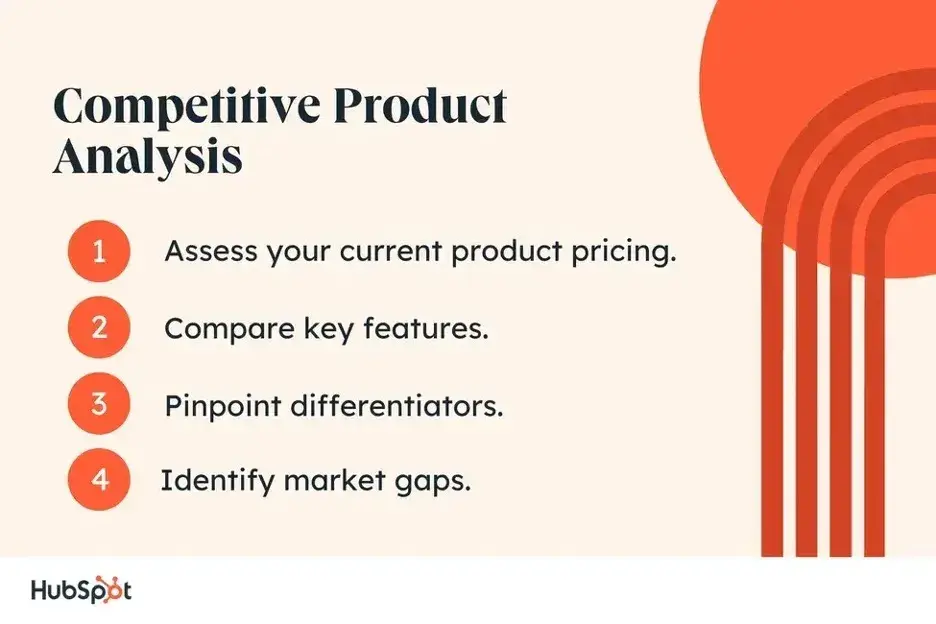
1. Assess your current product pricing.
The first step in any product analysis is to assess current pricing.
Nintendo offers three models of its Switch console: The lite version is priced at $199, the standard version is $299, and the OLED version is $349.
Sony offers five PlayStation 5 consoles: The digital edition costs $349, the disc edition costs $399, the digital edition (slim) costs $449, the disc edition (slim) costs $499, and the Pro costs $699.
2. Compare key features.
Next is a comparison of key features. In the case of our console example, this means comparing features like processing power, memory, and hard drive space.
|
Feature |
PS5 Disc edition |
Nintendo Switch |
|
Hard drive space |
825 GB |
32 GB |
|
RAM |
16 GB |
4 GB |
|
USB ports |
4 ports |
1 USB 3.0, 2 USB 2.0 |
|
Ethernet connection |
Gigabit |
None |
3. Pinpoint differentiators.
With basic features compared, it’s time to dive deeper with differentiators. While a glance at the chart above seems to indicate that the PS5 is outperforming its competition, this data only tells part of the story.
Here’s why: The big selling point of the standard and OLED Switch models is that they can be played as either handheld consoles or docked with a base station connected to a TV. What’s more, this “switching” happens seamlessly, allowing players to play whenever, wherever.
The PlayStation offering, meanwhile, has leaned into market-exclusive games that are only available on its system to help differentiate it from its competitors.
4. Identify market gaps.
The last step in a competitive product analysis is looking for gaps in the market that could help your company get ahead.
When it comes to the console market, one potential opportunity gaining traction is the delivery of games via cloud-based services rather than physical hardware.
Companies like Nvidia and Google have already made inroads in this space, and if they can overcome issues with bandwidth and latency, it could change the market at scale.
Competitive Analysis: FAQs
What is a competitive analysis framework?
A competitive analysis framework is a structured approach used to evaluate potential competitors. It guides businesses to identify competitive advantages, understand market positioning, and inform strategic decisions.
How do you do a good competitive analysis?
Conducting a thorough competitive analysis involves several steps:
- Identify competitors. Start by listing key competitors in your market, both direct and indirect.
- Evaluate their products/services. Analyze what they’re selling and how it compares to your offerings.
- Analyze market position. Determine their market share, brand perception, and unique value proposition.
- Check their marketing strategies. Observe their advertising, content marketing, PR efforts, and online presence.
- Assess their financial health. If available, review financial statements, annual reports, or investor presentations.
- Gather customer feedback. Reviews, testimonials, and surveys can give insights into competitor strengths and weaknesses.
- Regularly review and update. The market evolves, and competitors change strategies, so it’s vital to keep your analysis current.
What are the five parts of a competitive analysis?
The five key components of a competitive analysis include:
- Company overview. A brief snapshot of the competitor, including its history, size, and mission.
- Product/service analysis. An examination of their key products or services and how they compare to yours.
- Marketing strategy. Insights into their promotional tactics, target audience, and unique selling propositions.
- Operational analysis. An understanding of their supply chain, distribution, and customer service practices.
- Strengths and weaknesses. A clear breakdown of where the competitor excels and where they might be vulnerable.
What are the 3 C’s in a competitive analysis?
The 3 C’s refer to a strategic model that considers three main factors when understanding the broader business environment:
- Company. Understanding your own strengths, weaknesses, opportunities, and threats.
- Customers. Knowing who your target audience is, what they value, and how they behave.
- Competitors. Analyzing direct and indirect competitors to determine market dynamics and potential threats.
Is SWOT analysis a competitive analysis?
Yes, SWOT analysis is a type of competitive analysis. SWOT stands for Strengths, Weaknesses, Opportunities, and Threats. It is a strategic planning tool used to identify and analyze these four elements of a business.
While a SWOT analysis can be focused internally on a company‘s own attributes, when used as a competitive analysis tool, it assesses a competitor’s SWOT to understand where your business has advantages or might be vulnerable.
Wrap Up: Competitive Analysis in Marketing
In my years of experience, I’ve found that competitive analysis is crucial for business growth, but it starts with understanding your own position.
My top recommendation? Before comparing competitors, establish your own baseline.
Take an objective look at your business using the same metrics I discussed in this article for evaluating competitors. This self-assessment not only prepares you for a more accurate SWOT analysis but later helps you identify how your own strengths and weaknesses compare.
Remember, competitive analysis isn‘t a one-time task. Markets evolve, and so do competitors. Regular analysis helps you stay ahead of trends and adapt your strategies accordingly.
Editor’s Note: This post was originally published prior to June 2017 but has been updated for comprehensiveness.



![Download Now: 10 Competitive Analysis Templates [Free Templates]](https://no-cache.hubspot.com/cta/default/53/b3ec18aa-f4b2-45e9-851f-6d359263e671.png)
-1.webp?width=550&height=422&name=Copy%20of%20Memo%20Templates%20(7)-1.webp)
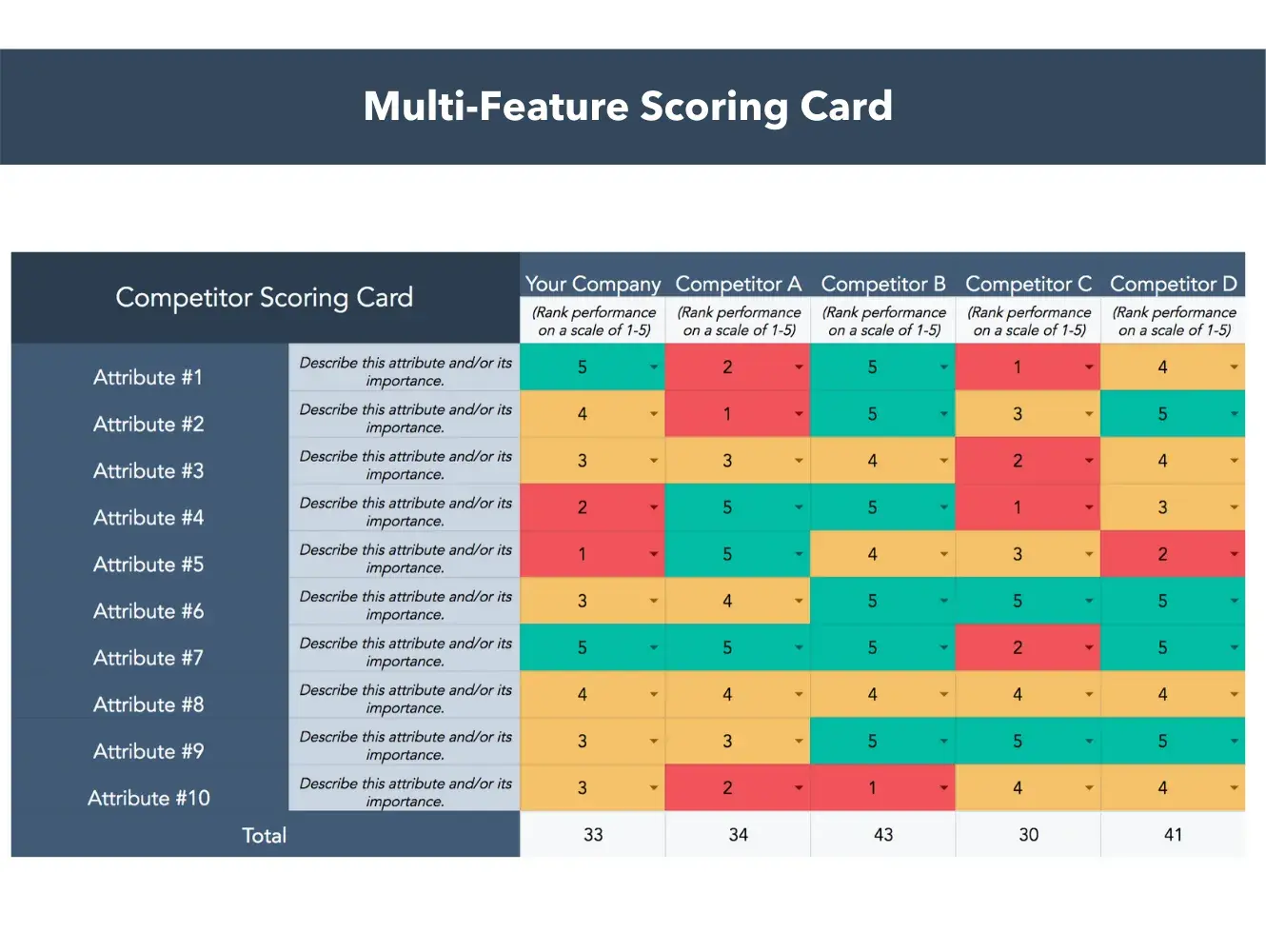












:max_bytes(150000):strip_icc()/GettyImages-2209058683-9728e0c7a1d741d28df2ab9f61215ffe.jpg?w=1920&resize=1920,1267&ssl=1)






